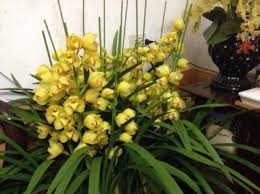# Sato Cymbidium Orchids and Their Cooperative Relationships with Other Flower Species

Sato Cymbidium orchids, renowned for their stunning beauty and vibrant colors, have become a favorite among horticulturists and flower enthusiasts alike. These remarkable orchids are not only admired for their elegance but also for their unique cooperative relationships with various plant species. Understanding these relationships provides insights into the ecological interactions that enhance biodiversity and promote thriving ecosystems. In this article, we will explore the Sato Cymbidium orchids’ unique characteristics, their natural habitats, and the flower species they commonly cooperate with, along with the benefits these relationships confer.
## 1. Understanding Sato Cymbidium Orchids
### a. Overview of Sato Cymbidium Orchids
Sato Cymbidium orchids belong to the genus *Cymbidium*, which comprises a wide variety of species native to Asia, Australia, and the Pacific Islands. Sato Cymbidium orchids are particularly noted for their large, showy blooms that can last for several weeks, making them popular in floral arrangements and exhibitions. They typically thrive in warm, humid environments, which mimic their natural habitat.
### b. Characteristics of Sato Cymbidium Orchids
– **Flower Structure:** Sato Cymbidium orchids feature a distinctive flower structure, characterized by three outer sepals and three inner petals, which often display intricate patterns and colors. The lip of the flower is usually larger and more elaborate, attracting pollinators.
– **Pseudobulbs:** These orchids develop pseudobulbs, which are thickened stems that store water and nutrients, helping the plant survive in fluctuating environmental conditions.
– **Leaf Arrangement:** The leaves of Sato Cymbidium orchids are long and strap-like, arranged in a rosette formation at the base of the plant. This leaf structure not only provides a stunning visual appeal but also aids in photosynthesis, crucial for the plant’s growth.
### c. Natural Habitat
In their natural habitat, Sato Cymbidium orchids can be found growing in a variety of environments, including tropical and subtropical forests, grasslands, and rocky outcrops. They often thrive in areas with dappled sunlight, where they receive indirect light while benefiting from high humidity levels. Understanding these habitat requirements is crucial for successful cultivation and care.
## 2. Cooperative Relationships with Other Flower Species
Sato Cymbidium orchids have formed beneficial relationships with various plant species in their ecosystems. These cooperative relationships enhance their growth, reproduction, and overall health. The following sections explore some of the key flower species that cooperate with Sato Cymbidium orchids and the benefits of these relationships.
### a. Symbiotic Relationships with Pollinators
One of the most significant cooperative relationships that Sato Cymbidium orchids engage in is with pollinators, particularly bees, butterflies, and hummingbirds. The vibrant colors and alluring scents of the orchids attract these pollinators, facilitating the transfer of pollen from one flower to another.
– **Pollinator Attraction:** Sato Cymbidium orchids produce nectar as a reward for visiting pollinators. This nectar serves as a food source for bees and other insects, encouraging them to visit the flowers frequently.
– **Cross-Pollination:** The interaction between Sato Cymbidium orchids and their pollinators promotes cross-pollination, which enhances genetic diversity and increases the chances of successful seed production.
### b. Mutualistic Relationships with Companion Plants
Sato Cymbidium orchids often coexist with various companion plants, creating mutually beneficial relationships that promote their growth and well-being.
– **Ferns:** Ferns, such as *Asplenium* and *Nephrolepis*, are commonly found alongside Sato Cymbidium orchids in their natural habitats. These ferns provide shade and help maintain humidity levels in the environment, creating a microclimate that is favorable for the orchids. In return, the orchids can help suppress weeds that may compete for nutrients and water.
– **Bromeliads:** Bromeliads are another type of plant that forms cooperative relationships with Sato Cymbidium orchids. These plants can hold water in their leaf axils, providing a natural reservoir for moisture that benefits the orchids during dry spells. In turn, the orchids contribute organic matter to the bromeliads, enhancing their nutrient uptake.
### c. The Role of Mycorrhizal Fungi
Mycorrhizal fungi play a crucial role in the health of Sato Cymbidium orchids by forming symbiotic relationships with their roots. This relationship enhances nutrient uptake and overall plant health.
– **Nutrient Exchange:** Mycorrhizal fungi colonize the roots of Sato Cymbidium orchids, extending their hyphae into the surrounding soil. This network increases the surface area for nutrient absorption, allowing the orchids to access essential minerals such as phosphorus and nitrogen that may be limited in the soil.
– **Disease Resistance:** The presence of mycorrhizal fungi can enhance the orchids’ resistance to pathogens and diseases. The fungi create a protective barrier around the roots, reducing the risk of root rot and other soil-borne diseases.
### d. Interactions with Other Orchid Species
Sato Cymbidium orchids also engage in cooperative relationships with other orchid species within their ecosystems. These interactions can be beneficial for both parties involved.
– **Hybridization Opportunities:** The close proximity of different orchid species may lead to hybridization, creating new and unique varieties of orchids. This genetic exchange can result in plants with improved traits, such as increased resilience to environmental stresses.
– **Shared Pollinators:** By sharing pollinators, Sato Cymbidium orchids and other orchids can benefit from increased visitation rates. This cooperative strategy enhances the chances of successful pollination for all species involved.
## 3. Ecological Benefits of Cooperative Relationships
The cooperative relationships formed by Sato Cymbidium orchids have significant ecological benefits that contribute to the overall health and balance of their ecosystems.
### a. Biodiversity Enhancement
By interacting with various flower species and other plants, Sato Cymbidium orchids contribute to biodiversity in their habitats. Increased biodiversity enhances ecosystem stability and resilience, providing benefits such as improved soil health and pest control.
### b. Habitat Stabilization
The presence of Sato Cymbidium orchids and their companion plants contributes to habitat stabilization. Their root systems help prevent soil erosion, while their foliage provides shelter and habitat for various insects and other wildlife.
### c. Food Web Dynamics
Sato Cymbidium orchids play a role in food web dynamics by serving as a food source for various pollinators and other herbivores. Their cooperative relationships with other plants and fungi further enhance nutrient cycling and energy flow within the ecosystem.
## 4. Cultivation Practices to Enhance Cooperative Relationships
For those interested in cultivating Sato Cymbidium orchids, implementing practices that enhance their cooperative relationships with other species can lead to healthier plants and more successful growth.
### a. Companion Planting Strategies
When cultivating Sato Cymbidium orchids, consider incorporating companion plants that promote humidity and provide beneficial shade. Ferns, bromeliads, and other orchids can be excellent choices to create a thriving micro-ecosystem.
### b. Utilizing Organic Practices
Using organic fertilizers and soil amendments can enhance the health of Sato Cymbidium orchids while promoting beneficial microbial activity in the soil, including mycorrhizal fungi.
### c. Creating a Pollinator-Friendly Environment
To attract pollinators, create a garden space that features a variety of flowering plants. This diversity will not only benefit the Sato Cymbidium orchids but also support overall pollinator health and biodiversity.
### d. Proper Water Management
Managing water levels is crucial for fostering healthy cooperative relationships. Ensure that Sato Cymbidium orchids are planted in well-draining potting mixes and that they receive adequate moisture without becoming waterlogged.
## 5. Conclusion
Sato Cymbidium orchids are not only stunning ornamental plants but also integral components of their ecosystems. Their cooperative relationships with various flower species, companion plants, and beneficial fungi contribute to their overall health and vitality. By understanding and enhancing these relationships through thoughtful cultivation practices, horticulturists and enthusiasts can create thriving environments that celebrate the beauty and complexity of nature.
In summary, the cooperative relationships formed by Sato Cymbidium orchids are diverse and multifaceted. They play a vital role in promoting biodiversity, enhancing ecosystem stability, and contributing to the overall health of their habitats. By fostering these relationships in cultivation, we can appreciate the beauty of Sato Cymbidium orchids while supporting the intricate web of life that surrounds them.
# Sato Cymbidium Orchids and Their Cooperative Relationships with Other Flower Species (Part 2)
In the first part of this article, we explored the beauty and characteristics of Sato Cymbidium orchids, their natural habitat, and the crucial role they play in cooperative relationships with other flower species. This second part will delve deeper into the various cooperative interactions, the ecological benefits of these relationships, and how gardeners can promote such beneficial associations to enhance the health and beauty of Sato Cymbidium orchids and their companions.
## 1. The Role of Sato Cymbidium Orchids in Ecosystems
### a. A Keystone Species
Sato Cymbidium orchids can be considered a keystone species within their ecosystems. As a keystone species, their presence and interactions significantly affect the structure and diversity of the ecological community. Their beautiful blooms attract a variety of pollinators, which in turn supports the reproduction of many plant species, enhancing biodiversity.
### b. Nutrient Cycling
The cooperative relationships that Sato Cymbidium orchids engage in also contribute to nutrient cycling within their ecosystems. The plants’ interactions with mycorrhizal fungi improve nutrient uptake, leading to enhanced growth and health. This, in turn, creates a more robust environment that benefits not just the orchids but also the surrounding flora and fauna.
### c. Supporting Pollinator Populations
Pollinators are essential for the reproductive success of many flowering plants. Sato Cymbidium orchids, by attracting various pollinators such as bees and butterflies, play a crucial role in supporting these populations. The more diverse the flowering species present in a habitat, the more likely it is that pollinator populations will thrive, contributing to overall ecological health.
## 2. Cooperative Relationships with Other Flower Species
Sato Cymbidium orchids often interact beneficially with other flowering plants, creating a web of support and mutualism in their ecosystems. Let’s explore some notable relationships.
### a. Companion Plants
#### i. Ferns
Ferns, such as *Asplenium* and *Nephrolepis*, are commonly found in the habitats of Sato Cymbidium orchids. These companion plants provide several benefits:
– **Humidity Regulation:** Ferns help maintain high humidity levels, crucial for the thriving of Sato Cymbidium orchids, which require moist environments for optimal growth.
– **Shade Provision:** The lush foliage of ferns can offer filtered light, mimicking the natural dappled sunlight of the orchids’ native habitats.
– **Soil Stabilization:** The root systems of ferns can help prevent soil erosion, creating a more stable environment for the orchids.
#### ii. Bromeliads
Bromeliads, which are often found in the same environments as Sato Cymbidium orchids, form another beneficial relationship:
– **Water Reservoirs:** Bromeliads can store water in their leaf axils, providing a source of moisture for the orchids during dry spells. This symbiotic arrangement allows both plants to thrive in conditions that may otherwise be challenging.
– **Nutrient Contribution:** As organic matter accumulates in the water held by bromeliads, it can provide nutrients that benefit Sato Cymbidium orchids.
### b. Flowering Ground Covers
Ground cover plants, such as creeping thyme (*Thymus serpyllum*) and sedums, can enhance the habitat for Sato Cymbidium orchids in several ways:
– **Weed Suppression:** Ground covers can compete with weeds, reducing competition for nutrients and water that Sato Cymbidium orchids rely on for healthy growth.
– **Soil Health:** These plants can improve soil structure and health, leading to better drainage and aeration, which are crucial for orchid root systems.
## 3. Cooperative Relationships with Pollinators
Pollinators play an integral role in the life cycle of Sato Cymbidium orchids. The interactions between the orchids and these insects are complex and beneficial for both parties.
### a. Nectar Production
Sato Cymbidium orchids produce nectar to attract pollinators, which is critical for their reproductive success. Here’s how this interaction unfolds:
– **Pollinator Attraction:** The sweet scent and bright colors of the flowers draw in pollinators like bees, butterflies, and hummingbirds. These creatures visit the flowers to feed on nectar.
– **Pollen Transfer:** While feeding, pollinators inadvertently brush against the orchid’s reproductive structures, transferring pollen to other flowers and facilitating cross-pollination. This process not only helps the orchids reproduce but also ensures genetic diversity.
### b. Pollinator Diversity
The diversity of pollinators visiting Sato Cymbidium orchids is crucial for maintaining healthy ecosystems. A diverse pollinator community can lead to more robust plant populations, as different species may have varying abilities to pollinate flowers effectively. This diversity helps maintain ecological balance, promoting resilience against environmental changes.
## 4. Mycorrhizal Relationships
Mycorrhizal fungi are essential partners for Sato Cymbidium orchids. The symbiotic relationship they form provides numerous benefits:
### a. Enhanced Nutrient Uptake
– **Nutrient Acquisition:** Mycorrhizal fungi colonize the roots of Sato Cymbidium orchids, extending their hyphae into the surrounding soil. This increases the surface area available for nutrient absorption, allowing the orchids to access vital nutrients such as phosphorus, nitrogen, and potassium more effectively.
– **Access to Water:** The fungal network also helps improve water uptake, which is essential for the orchids, particularly in environments where water may be limited.
### b. Disease Resistance
Mycorrhizal fungi provide a protective barrier around the roots of Sato Cymbidium orchids, helping to prevent root rot and other soil-borne diseases. This mutualistic relationship enhances the overall health of the orchids, allowing them to thrive in various conditions.
## 5. Ecological Benefits of Cooperative Relationships
The cooperative relationships that Sato Cymbidium orchids engage in provide significant ecological benefits that contribute to the health and stability of their ecosystems.
### a. Biodiversity Promotion
The interactions between Sato Cymbidium orchids, their companion plants, and pollinators promote biodiversity. The presence of various species creates a dynamic environment where different plants and animals can coexist, enhancing the overall health of the ecosystem.
### b. Soil Health Improvement
Cooperative relationships contribute to soil health through improved nutrient cycling and organic matter decomposition. The combination of orchid roots, companion plants, and mycorrhizal fungi enhances soil structure, aeration, and nutrient availability, benefiting all plant species in the area.
### c. Ecosystem Resilience
Diverse plant communities, including Sato Cymbidium orchids and their cooperative partners, create resilient ecosystems capable of withstanding environmental stresses. This resilience is crucial for adapting to climate change, pests, and diseases.
## 6. Cultivating Sato Cymbidium Orchids with Cooperative Relationships in Mind
For gardeners and horticulturists, fostering cooperative relationships can enhance the health and beauty of Sato Cymbidium orchids. Here are some practical strategies:
### a. Selecting Companion Plants
Choose companion plants that naturally grow alongside Sato Cymbidium orchids in their native habitats. Incorporating ferns, bromeliads, and flowering ground covers can create a supportive micro-ecosystem that enhances humidity and provides nutrients.
### b. Creating Pollinator Gardens
Design your garden to attract a variety of pollinators. Planting a diverse range of flowering species that bloom at different times of the year can provide a continuous food source for pollinators, ensuring they visit your Sato Cymbidium orchids.
### c. Using Organic Practices
Employing organic gardening practices, such as using compost and natural fertilizers, supports soil health and promotes beneficial microbial activity, including mycorrhizal fungi. This approach enhances nutrient availability for Sato Cymbidium orchids and their companions.
### d. Proper Water Management
Ensure that Sato Cymbidium orchids receive adequate moisture while maintaining good drainage. Overwatering can lead to root rot, while underwatering can stress the plants. Implementing a well-balanced watering schedule is crucial for their success.
### e. Monitoring and Adapting
Regularly monitor the health of your Sato Cymbidium orchids and their companions. Observe any changes in growth or flowering patterns, and be ready to adapt your care practices as needed. Adjustments to light, water, or nutrient levels can make a significant difference in the overall health of your plants.
## 7. Conclusion
Sato Cymbidium orchids are remarkable plants that embody the beauty of nature’s cooperative relationships. Their interactions with companion plants, pollinators, and mycorrhizal fungi create a dynamic web of support that enhances biodiversity, promotes soil health, and contributes to the stability of ecosystems.
By understanding and fostering these relationships, gardeners and horticulturists can create thriving environments that celebrate the intricate connections between Sato Cymbidium orchids and the other flower species that share their space. In doing so, they not only cultivate stunning displays of orchids but also contribute to the health and resilience of our planet’s ecosystems. Embracing these cooperative interactions allows us to appreciate the beauty of Sato Cymbidium orchids and the vital role they play in our gardens and natural landscapes.

